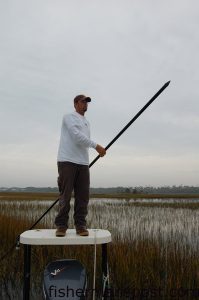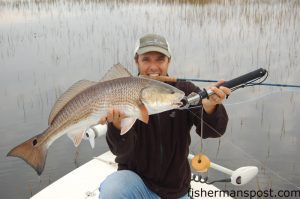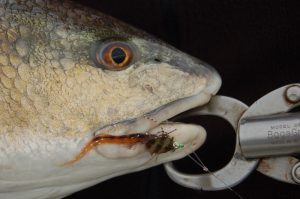The Road To Redfish – The Road (To Redfish) Less Traveled

Capt. Jon Huff, of Circle H Charters out of Wrightsville Beach, poles his Maverick 17 Master Angler through a flooded flat in the lower Cape Fear River to set up on a tailing red just off of a grass bed.
Fishing is a challenge, and fly fishing is even more of a challenge. So when Gary Hurley and I decided to chronicle the journey from novice to accomplished (hopefully) fly fisher in a series of articles over the course of a season, we knew we had our work cut out for us.
It takes a serious commitment to learn, practice, and get out on the water enough to actually have the opportunity to get a shot at a redfish on the fly, let alone be fortunate enough to catch one in your first year. However, Gary was obviously committed to the task at hand, as was I, and over this past year we pursued this goal together through casting lessons, casting practice, and a few on-the-water days to put Gary’s new skills to practical use.
The first few times we made it out on the water were only for a limited number of hours each time, and although we did not connect with any reds, our time on the boat was invaluable as it provided real fly fishing experience. Little did we know that the next date that we picked to fish (and this time we actually scheduled an entire day) would present some of the best and most exciting fly fishing for reds that I had ever encountered and arguably some the best and most exciting fly fishing for anything that I had ever seen.
It was so good, in fact, that we only needed about an hour and a half to catch Gary’s first TWO redfish on the fly, and these were both “tailing” reds in a foot of water or less.
We started out the day with a 5:30 AM weather check, a phone call to see if the predicted heavy rains would spoil our day or would the weather hold off long enough to allow us a chance to get out on the water. Luckily, it looked as if we would get an early window of opportunity and would not be fishing in the rain all day, as we both had expected.
The early morning was overcast with no rain. In fact, there wasn’t a breath of wind. The surface of the water was as slick as glass, the sand gnats were abundant and ravenous, and the tide was flooding the marsh. These are all great signs that the reds might “tail,” wagging their tails above the surface of the water while feeding on the bottom in shallow water.
“Tailing” fish are some of the most exciting fish to attempt to catch, and they call for tactics that resemble hunting and fishing combined. Well, not only had Gary and I been fortunate enough to be on the flat under ideal conditions that day, but we spotted tailing fish almost immediately. This not only set the tone for the morning but also made it difficult for Gary to ease into the morning’s fishing. He wouldn’t be able to take his time to warm up. Our fly trip became a high pressure game right away.
We watched several big reds tail within a hundred feet of us while we attempted to silently push-pole across the flat and get into position for a cast. As I picked a route across the shallows, Gary was throwing a few practice casts at random blades of marsh grass, and he warmed up rather quickly laying out a few smooth, accurate 35-40 foot casts.
The situation that morning with fish already visible was enough to give an experienced fly fisherman the marine equivalent of “buck fever,” so I suggested to Gary that he should stop practicing and visualize an accurate cast a few feet in front of the fish’s expected line of travel and a few feet beyond, allowing the fly to be presented into the fish’s feeding window by manipulating the timing of the retrieve.
We talked about seeing it all come together in his head: a tailing fish within range, an adequate cast, a perfectly timed retrieve, and a proper hookset, one using only the line hand and a long strip to set the hook as opposed to any rod movement. What we didn’t talk about was what to do after a fish was hooked. We hadn’t gotten that far yet, and what happened next kind of caught us both by surprise.
We managed to glide across the flooded marsh into a small spot behind some exposed grass while a pod of five or six upper-slot reds were feeding and tailing. As the boat settled into position, two reds that I hadn’t noticed before spooked and shot out around the boat. Our other two fish, though, continued to forage on the bottom waving their tails in the air, unaware of our presence just 25 or so feet away.

Hurley's second redfish on the fly, a 30" fish, quickly took him "on the reel". The 10 lb. class red hit on a flooded flat in the lower Cape Fear River with Capt. Jon Huff of Circle H Charters on the poling platform.
I think the visualization must have worked because Gary laid out a perfect cast and began the retrieve trying to mimic a small, fleeing crab or shrimp. His retrieve was suddenly stopped after only a few inches by the attack of a hungry redfish. I hollered to Gary to set the hook, that the fish had eaten the fly, and as he pulled the line behind himself with his left hand to set the hook, he was tight to his first ever redfish on the fly.
Now we had not really gone over what to do next, as everything had happened so fast that morning, and this fish stayed fairly close to the boat for the entire fight so we had a real world lesson on how to fight a fish on fly tackle “off the reel.”
Reds, unlike say a bonefish, will often tussle it out in close quarters, as opposed to speeding off in one direction for any distance. I usually explain to an angler that the fish will either put you “on the reel” (where you can utilize the reel’s drag and retrieve capabilities to subdue it) or the fish won’t run far enough to take up any extra slack, and you have to fight the fish “off the reel” (using your hands as both a drag and line retrieval device).
And this is just what Gary had to do, with a little coaching from yours truly. Once he got the hang of it, he tired his first redfish out within minutes and without ever touching the reel. The product? A very healthy 25-incher. We had done it. We had accomplished our goal, and the pressure was off. Pictures were taken, and our accomplishment was officially documented.
The celebration didn’t last long, though, as the conditions were still perfect and we could still see several reds (some rather large) actively feeding and tailing. We regrouped and picked out a line to sneak up on some more fish to try our luck again.
I had not poled the boat a hundred feet when a tail appeared on the edge of some grass in front of us. Without me saying a word, Gary placed a cast in front of the fish. And again, barely into the start of his retrieve, he was hooked up to his second redfish of the morning!
This fish was bigger and took all of the slack and was on the reel right away, so this time Gary could utilize the reel’s drag to tire the fish and the handle to retrieve line. Not only was Gary fast to his second red on the fly, he was lucky enough to see both scenarios, fighting a fish both “on the reel” and “off the reel” on his first two fish.
We played this redfish for a bit longer, and when I clipped the Boga Grip around its lower jaw we were both elated to have caught a second fish in the 30 inch range and into the double digits in pounds. As we got back into the hunt again, several fish were still tailing and we had one more shot at a fish. This one, however, must have suspected our presence as it just sunk into the grass as Gary cast to it and then simply vanished out of sight.

This redfish fell for a custom tan and chartreuse kwan pattern tied by Dr. Keith Gallaher who hosts a yearly children's charity Tie-a-thon.
What a morning we had: two for three on redfish with the fly rod! Gary and I had put a considerable amount of effort into this project, and to say we were grateful and fortunate to have it all come together as it did is an understatement. Gary’s challenge to himself to undertake and learn to fly fish and our goal of covering it in our series “The Road to Redfish” was a success.
Fishing since that day has been nothing short of incredible, and one of my good friends and very experienced fly fishing clients had a personal best 16.5 lb., 33” redfish on the fly just last week. This was also the biggest redfish that I have ever guided anyone to on fly in all my years of guiding. This big red was shallow, and I mean really shallow. So shallow, in fact, that he had to pass within mere feet of the boat on his escape because everywhere any more than a few feet on either side of the boat was almost dry.
I also had the privilege of starting the instruction of a thirteen year old fly fishing student, who on his first morning with me was already throwing a tight loop. His enthusiasm and potential were inspiring.
I hope that this series “The Road to Redfish” will inspire some of you to try your hand at fly fishing and to experience the many great opportunities that our region has to offer. Please feel free to give me a call with any questions you may have regarding fly fishing in our area, especially if you would like to start your own journey with a fly rod.
Thanks for reading, and hope to see you on the water!
Capt. Jon Huff
Capt. Jon Huff is owner operator of Circle H Charters, an inshore fly and light tackle guide service based out of Wrightsville Beach. Jon splits his time between running inshore charters, fishing offshore tournaments, and co-managing Intracoastal Angler. (910) 617-2619, www.circlehcharters.com
